-
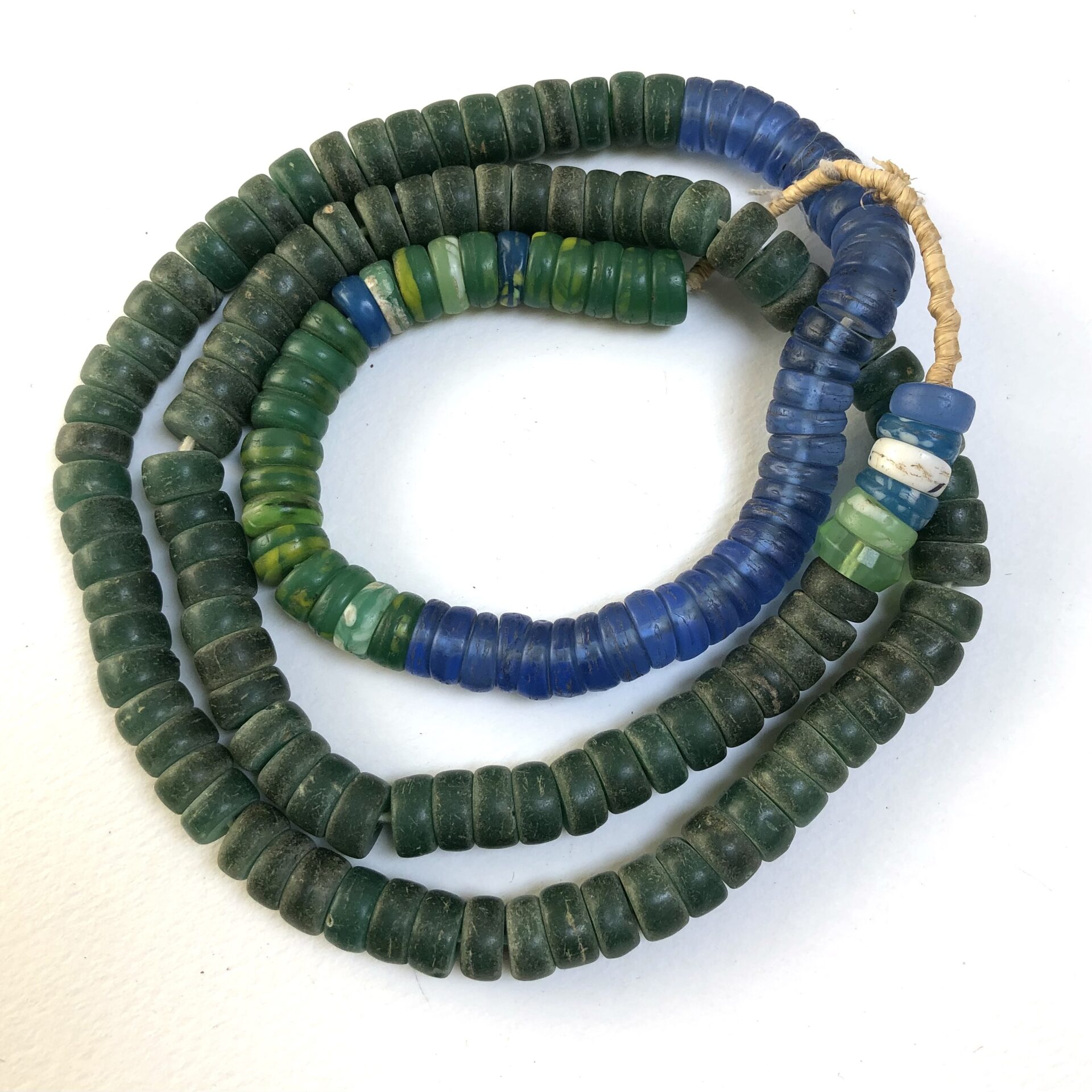
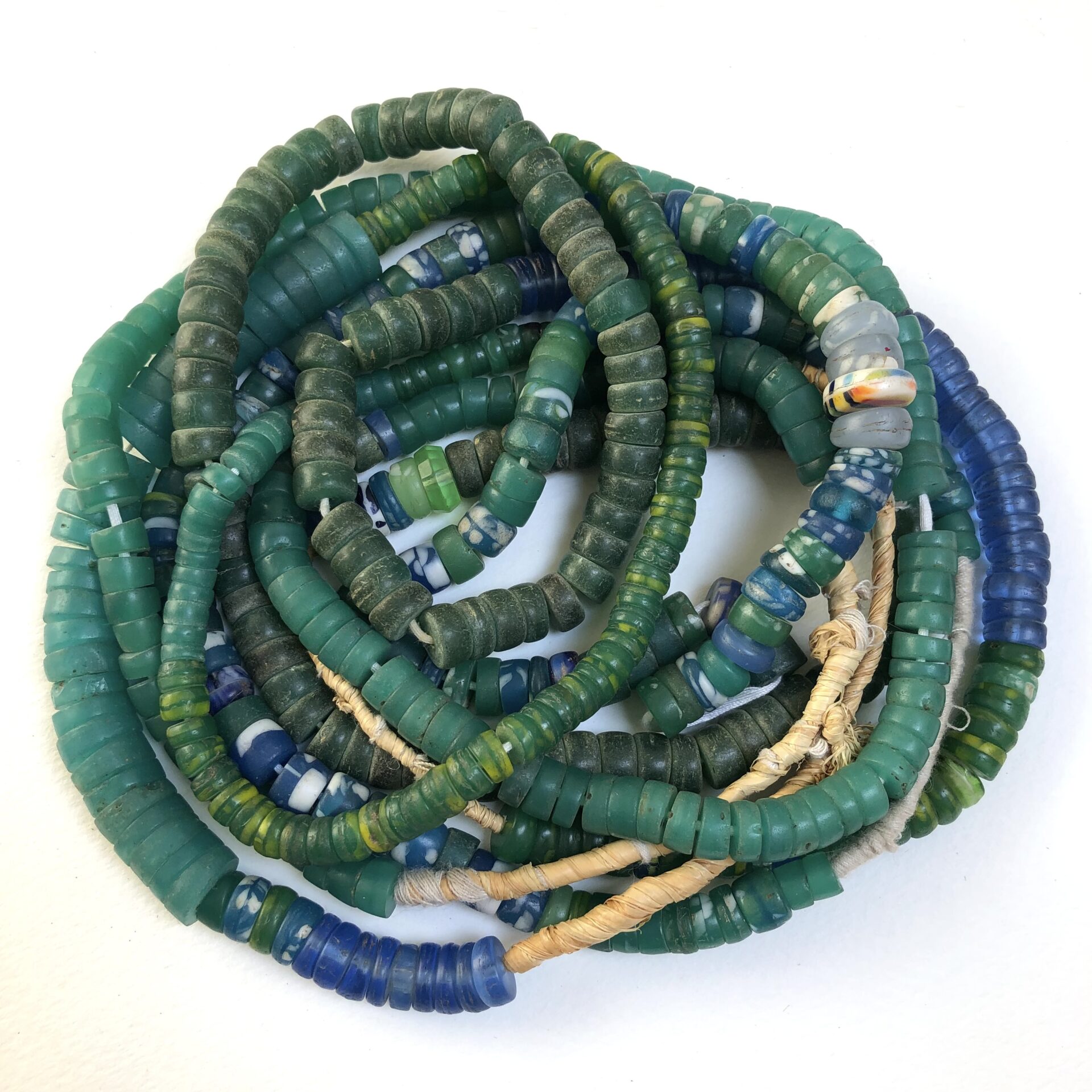 There are 4 strands of Kakamba Prosser for you to choose from. These are great spacer beads. Prosser beads are by extension any beads made by the 'Prosser' technique, invented by the Prosser brothers in 1840 in England for the purpose of making buttons. The process consists of molding a cold paste under great pressure and then firing it. Prosser Beads were distinct from other European trade beads in that they were produced in a great variety of colors, and were also translucent. They were received particularly well in the town of Kakamba in the Republic of the Congo – hence the name Kakamba Prosser Beads.
There are 4 strands of Kakamba Prosser for you to choose from. These are great spacer beads. Prosser beads are by extension any beads made by the 'Prosser' technique, invented by the Prosser brothers in 1840 in England for the purpose of making buttons. The process consists of molding a cold paste under great pressure and then firing it. Prosser Beads were distinct from other European trade beads in that they were produced in a great variety of colors, and were also translucent. They were received particularly well in the town of Kakamba in the Republic of the Congo – hence the name Kakamba Prosser Beads. -
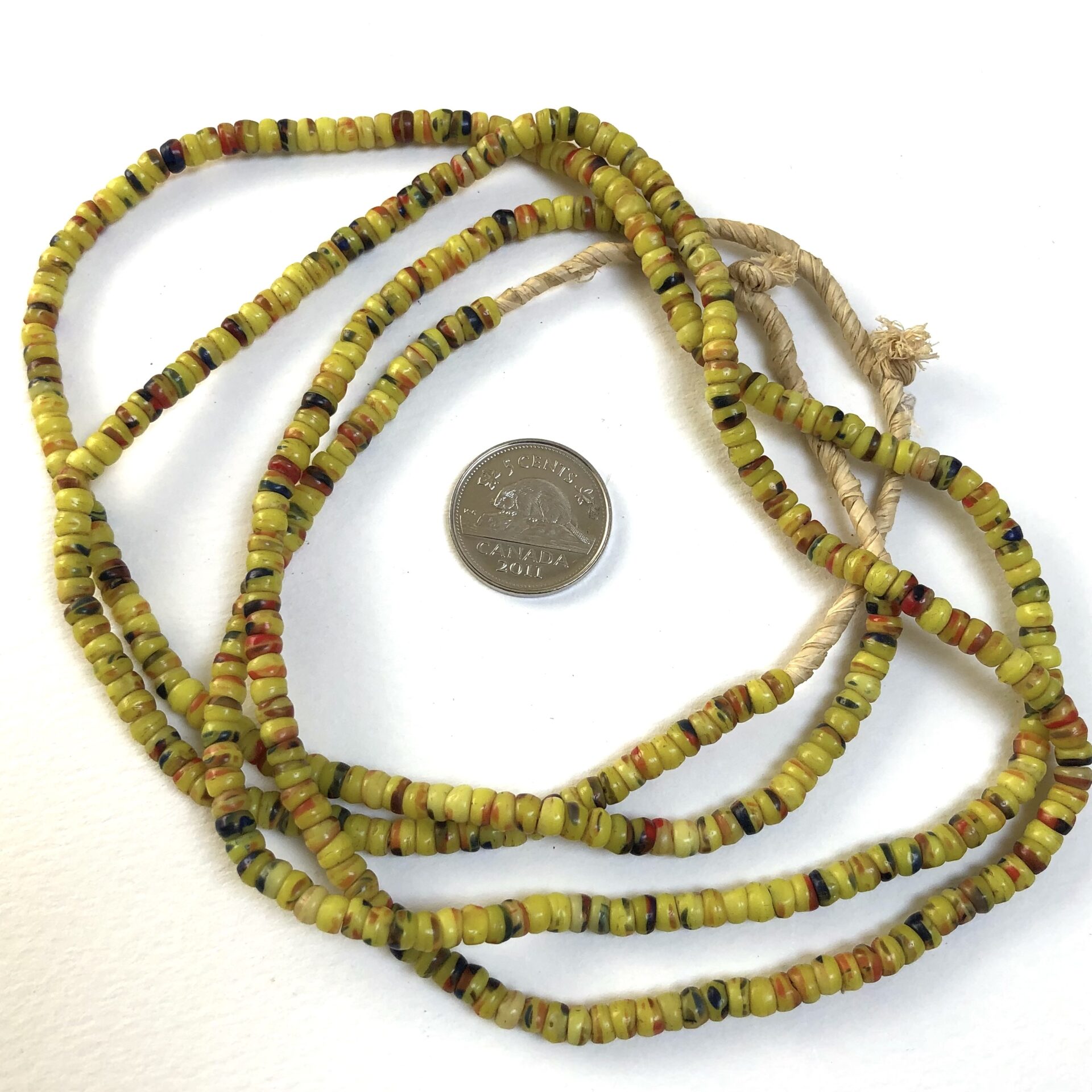
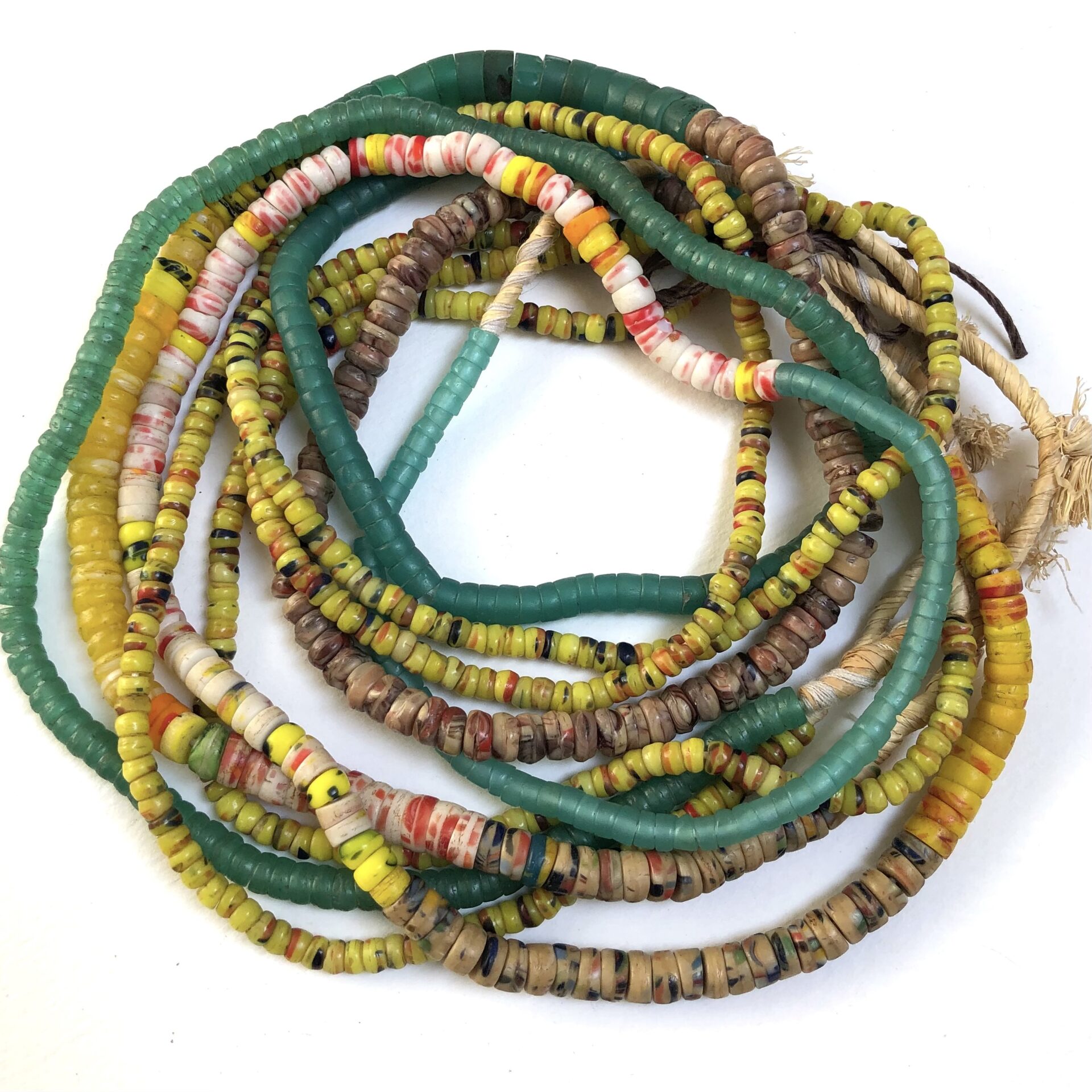 A strand of Kakamba Prosser Beads about 24" long. There are 4 strands for you to choose from. These are great spacer beads. Prosser beads are by extension any beads made by the 'Prosser' technique, invented by the Prosser brothers in 1840 in England for the purpose of making buttons. The process consists of molding a cold paste under great pressure and then firing it. Prosser Beads were distinct from other European trade beads in that they were produced in a great variety of colors, and were also translucent. They were received particularly well in the town of Kakamba in the Republic of the Congo – hence the name Kakamba Prosser Beads.
A strand of Kakamba Prosser Beads about 24" long. There are 4 strands for you to choose from. These are great spacer beads. Prosser beads are by extension any beads made by the 'Prosser' technique, invented by the Prosser brothers in 1840 in England for the purpose of making buttons. The process consists of molding a cold paste under great pressure and then firing it. Prosser Beads were distinct from other European trade beads in that they were produced in a great variety of colors, and were also translucent. They were received particularly well in the town of Kakamba in the Republic of the Congo – hence the name Kakamba Prosser Beads. -
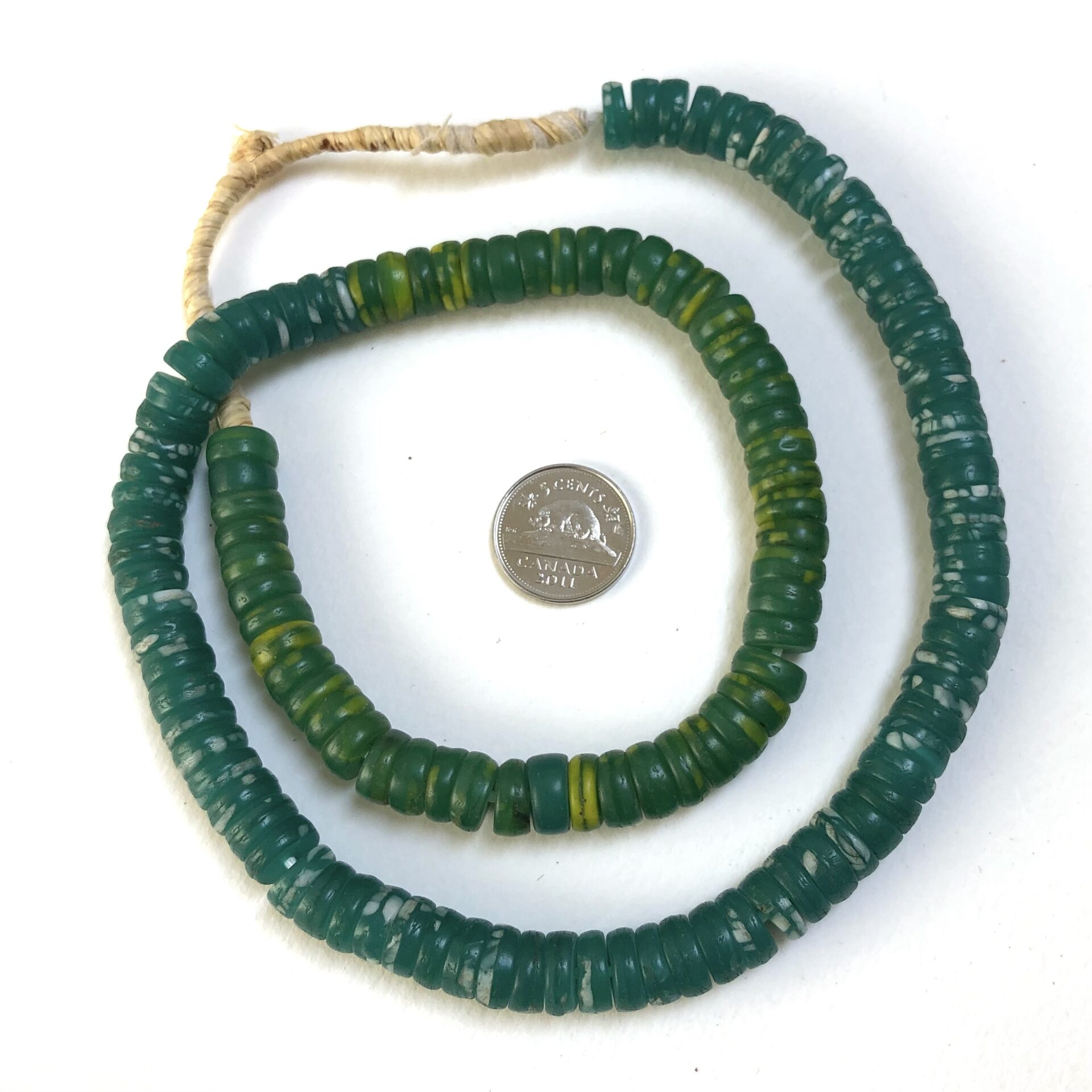
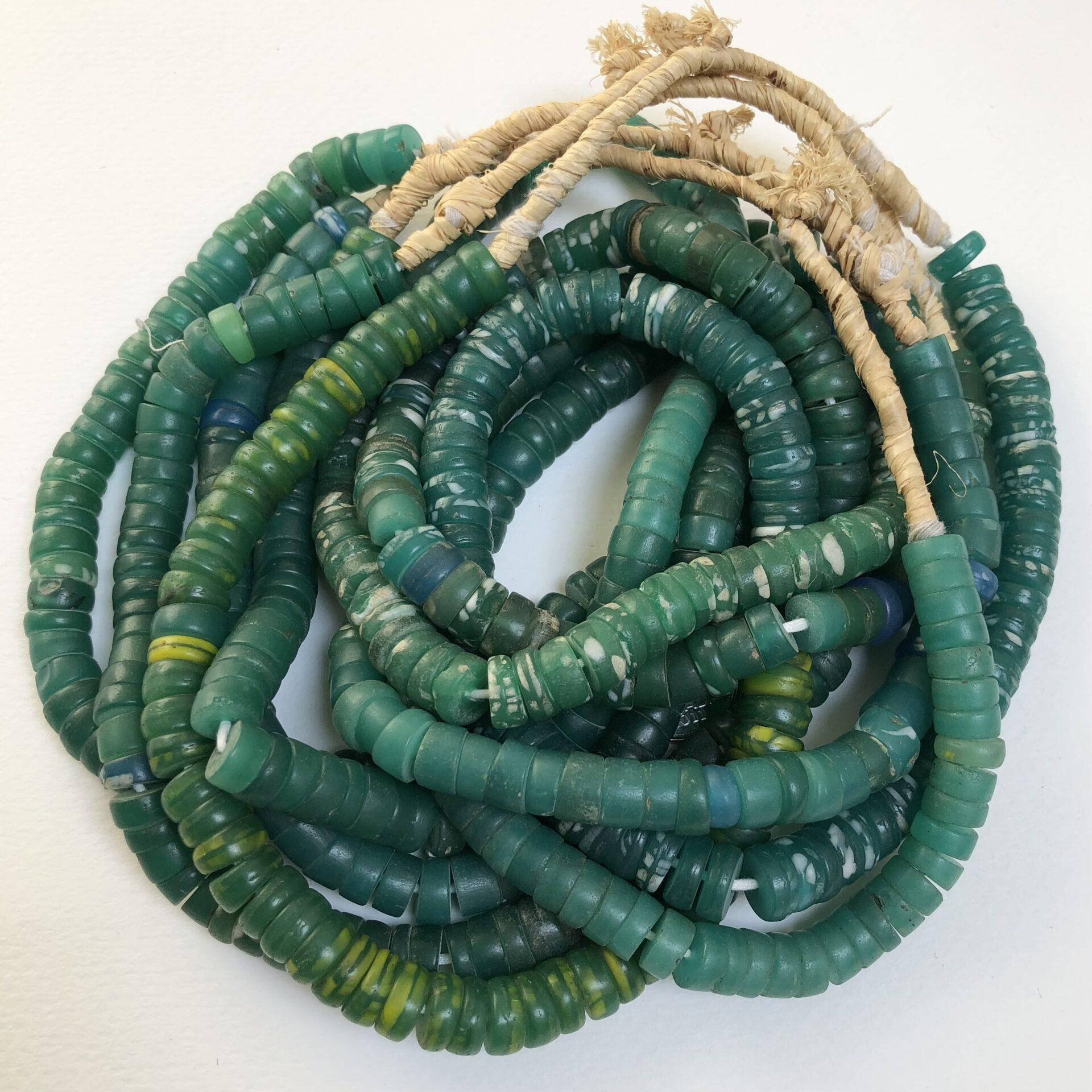 A strand of Kakamba Prosser Beads about 24" long. There are 5 strands for you to choose from. These are great spacer beads. Prosser beads are by extension any beads made by the 'Prosser' technique, invented by the Prosser brothers in 1840 in England for the purpose of making buttons. The process consists of molding a cold paste under great pressure and then firing it. Prosser Beads were distinct from other European trade beads in that they were produced in a great variety of colors, and were also translucent. They were received particularly well in the town of Kakamba in the Republic of the Congo – hence the name Kakamba Prosser Beads.
A strand of Kakamba Prosser Beads about 24" long. There are 5 strands for you to choose from. These are great spacer beads. Prosser beads are by extension any beads made by the 'Prosser' technique, invented by the Prosser brothers in 1840 in England for the purpose of making buttons. The process consists of molding a cold paste under great pressure and then firing it. Prosser Beads were distinct from other European trade beads in that they were produced in a great variety of colors, and were also translucent. They were received particularly well in the town of Kakamba in the Republic of the Congo – hence the name Kakamba Prosser Beads. -
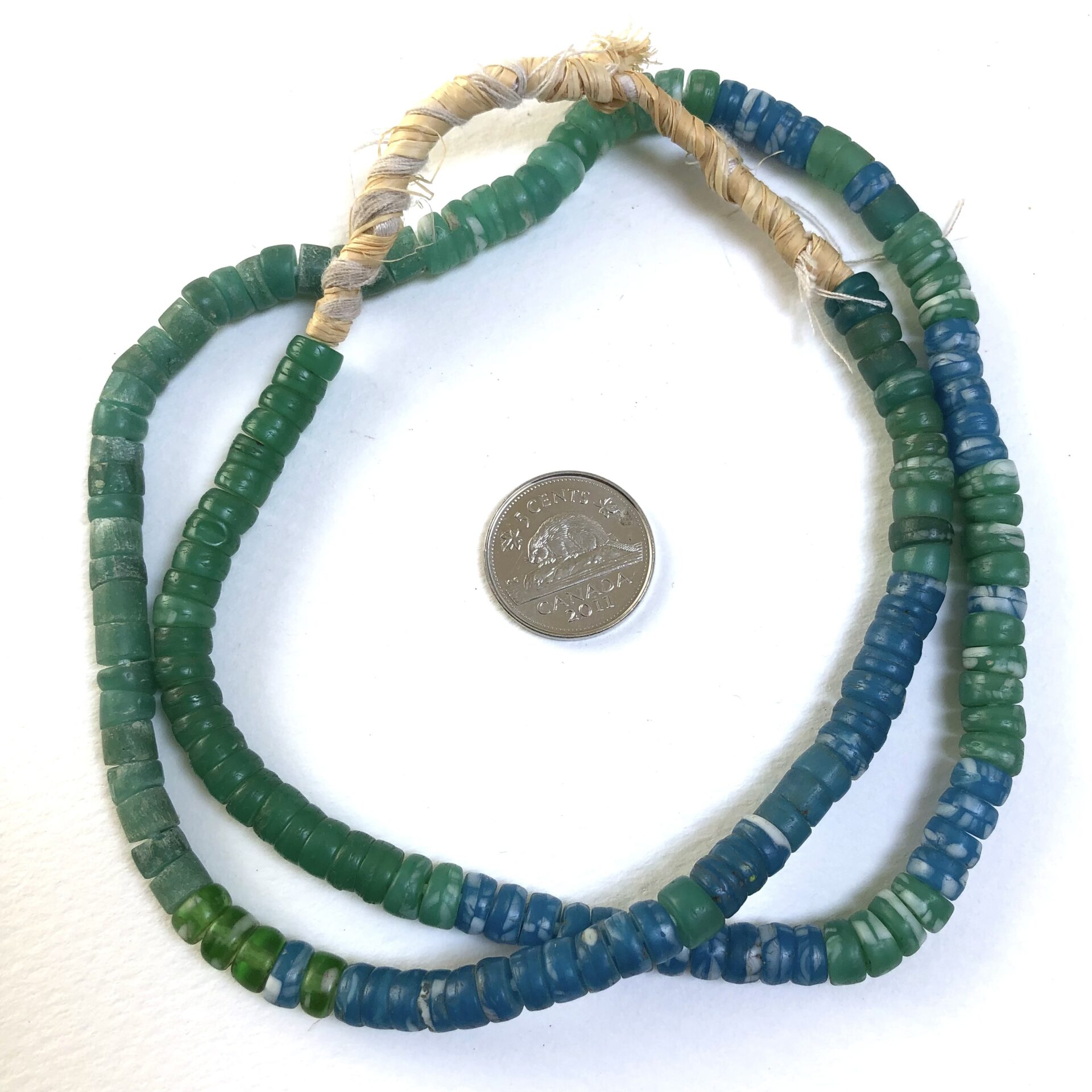
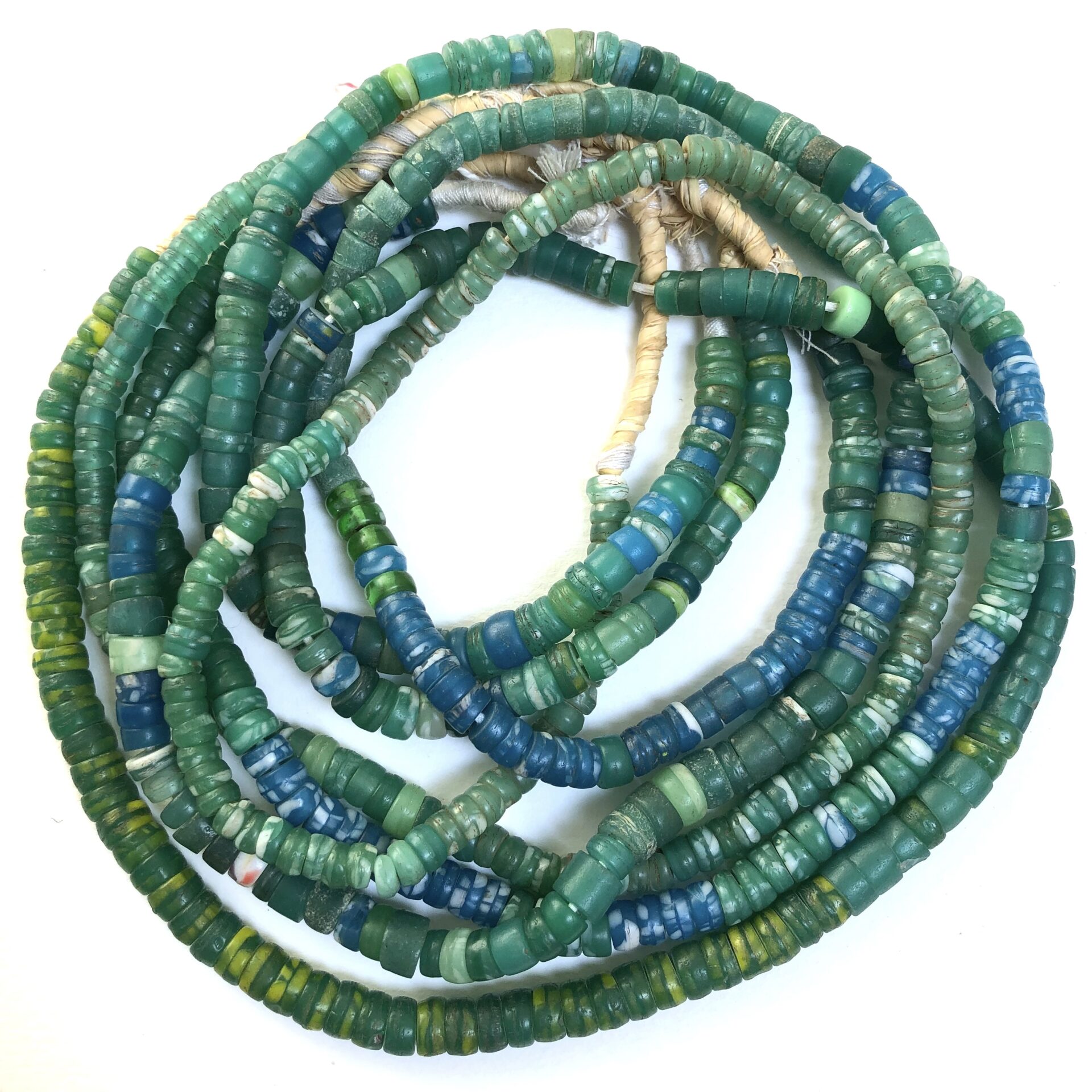 A strand of Kakamba Prosser Beads about 24" long. There are 4 strands for you to choose from. These are great spacer beads. Prosser beads are by extension any beads made by the 'Prosser' technique, invented by the Prosser brothers in 1840 in England for the purpose of making buttons. The process consists of molding a cold paste under great pressure and then firing it. Prosser Beads were distinct from other European trade beads in that they were produced in a great variety of colors, and were also translucent. They were received particularly well in the town of Kakamba in the Republic of the Congo – hence the name Kakamba Prosser Beads.
A strand of Kakamba Prosser Beads about 24" long. There are 4 strands for you to choose from. These are great spacer beads. Prosser beads are by extension any beads made by the 'Prosser' technique, invented by the Prosser brothers in 1840 in England for the purpose of making buttons. The process consists of molding a cold paste under great pressure and then firing it. Prosser Beads were distinct from other European trade beads in that they were produced in a great variety of colors, and were also translucent. They were received particularly well in the town of Kakamba in the Republic of the Congo – hence the name Kakamba Prosser Beads. -
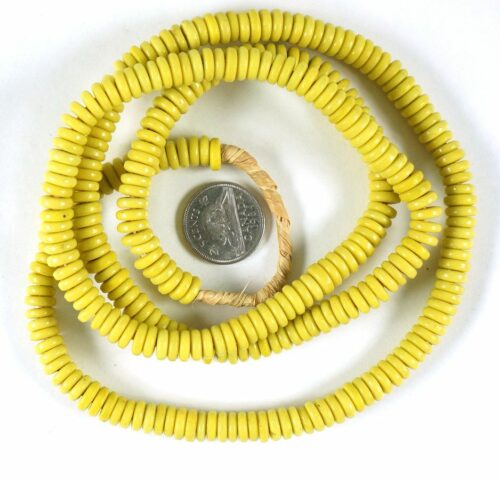
 A strand of yellow button-like Prosser Beads on raffia 34" long. The beads are around 6 mm. Hole opening around .5 mm. These are great spacer beads. Prosser beads are by extension any beads made by the 'Prosser' technique, invented by the Prosser brothers in 1840 in England for the purpose of making buttons. The process consists of molding a cold paste under great pressure and then firing it.
A strand of yellow button-like Prosser Beads on raffia 34" long. The beads are around 6 mm. Hole opening around .5 mm. These are great spacer beads. Prosser beads are by extension any beads made by the 'Prosser' technique, invented by the Prosser brothers in 1840 in England for the purpose of making buttons. The process consists of molding a cold paste under great pressure and then firing it. -

 A strand of small yellow button-like Prosser Beads on raffia 30" long. Each bead is about 8 mm in diameter with the hole opening around .5 mm. These are great spacer beads. There are 4 strands - you will receive one similar to the strands in photo. Prosser beads are by extension any beads made by the 'Prosser' technique, invented by the Prosser brothers in 1840 in England for the purpose of making buttons. The process consists of molding a cold paste under great pressure and then firing it.
A strand of small yellow button-like Prosser Beads on raffia 30" long. Each bead is about 8 mm in diameter with the hole opening around .5 mm. These are great spacer beads. There are 4 strands - you will receive one similar to the strands in photo. Prosser beads are by extension any beads made by the 'Prosser' technique, invented by the Prosser brothers in 1840 in England for the purpose of making buttons. The process consists of molding a cold paste under great pressure and then firing it. -
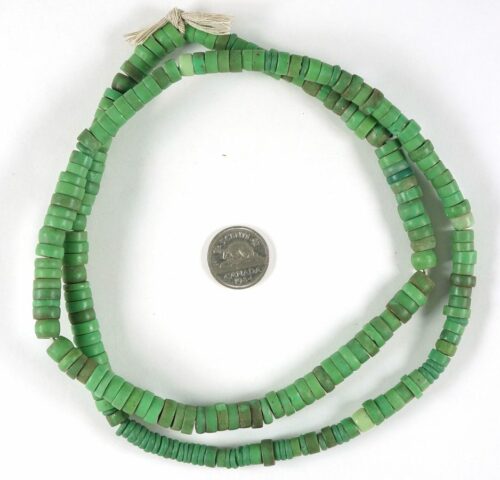
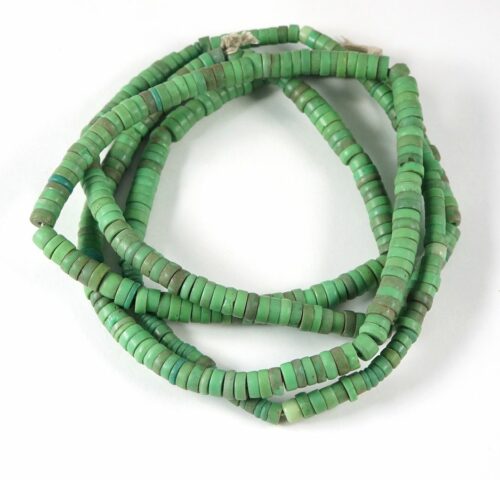 A strand of green button-like Prosser Beads on string 30" long. The beads are varying sizes, around 5 mm to 7 mm. Hole opening around .5 mm. These are great spacer beads. You will received the image with the penny. Prosser beads are by extension any beads made by the 'Prosser' technique, invented by the Prosser brothers in 1840 in England for the purpose of making buttons. The process consists of molding a cold paste under great pressure and then firing it.
A strand of green button-like Prosser Beads on string 30" long. The beads are varying sizes, around 5 mm to 7 mm. Hole opening around .5 mm. These are great spacer beads. You will received the image with the penny. Prosser beads are by extension any beads made by the 'Prosser' technique, invented by the Prosser brothers in 1840 in England for the purpose of making buttons. The process consists of molding a cold paste under great pressure and then firing it. -

 A strand of 175 small green button-like Prosser Beads on raffia 26" long. Each bead is about 7 mm in diameter. These are great spacer beads. Prosser beads are by extension any beads made by the 'Prosser' technique, invented by the Prosser brothers in 1840 in England for the purpose of making buttons. The process consists of molding a cold paste under great pressure and then firing it.
A strand of 175 small green button-like Prosser Beads on raffia 26" long. Each bead is about 7 mm in diameter. These are great spacer beads. Prosser beads are by extension any beads made by the 'Prosser' technique, invented by the Prosser brothers in 1840 in England for the purpose of making buttons. The process consists of molding a cold paste under great pressure and then firing it. -

 A strand of Kakamba Prosser Beads about 24" long. The glass beads are about 3-4 mm in diameter. These are great spacer beads.3/4 of the beads are a translucent yellot and the rest are an opaque yellow, black and red mix. Prosser beads are by extension any beads made by the 'Prosser' technique, invented by the Prosser brothers in 1840 in England for the purpose of making buttons. The process consists of molding a cold paste under great pressure and then firing it. Prosser Beads were distinct from other European trade beads in that they were produced in a great variety of colors, and were also translucent. They were received particularly well in the town of Kakamba in the Republic of the Congo – hence the name Kakamba Prosser Beads.
A strand of Kakamba Prosser Beads about 24" long. The glass beads are about 3-4 mm in diameter. These are great spacer beads.3/4 of the beads are a translucent yellot and the rest are an opaque yellow, black and red mix. Prosser beads are by extension any beads made by the 'Prosser' technique, invented by the Prosser brothers in 1840 in England for the purpose of making buttons. The process consists of molding a cold paste under great pressure and then firing it. Prosser Beads were distinct from other European trade beads in that they were produced in a great variety of colors, and were also translucent. They were received particularly well in the town of Kakamba in the Republic of the Congo – hence the name Kakamba Prosser Beads. -

 A strand of Kakamba Prosser Beads about 23" long. The glass beads are about 5 mm in diameter. These are great spacer beads. An assortment of colours. You will receive a strand similar to the strands shown. There are variations between strands. Prosser beads are by extension any beads made by the 'Prosser' technique, invented by the Prosser brothers in 1840 in England for the purpose of making buttons. The process consists of molding a cold paste under great pressure and then firing it. Prosser Beads were distinct from other European trade beads in that they were produced in a great variety of colors, and were also translucent. They were received particularly well in the town of Kakamba in the Republic of the Congo – hence the name Kakamba Prosser Beads.
A strand of Kakamba Prosser Beads about 23" long. The glass beads are about 5 mm in diameter. These are great spacer beads. An assortment of colours. You will receive a strand similar to the strands shown. There are variations between strands. Prosser beads are by extension any beads made by the 'Prosser' technique, invented by the Prosser brothers in 1840 in England for the purpose of making buttons. The process consists of molding a cold paste under great pressure and then firing it. Prosser Beads were distinct from other European trade beads in that they were produced in a great variety of colors, and were also translucent. They were received particularly well in the town of Kakamba in the Republic of the Congo – hence the name Kakamba Prosser Beads. -

 A strand of over 150 Kakamba Prosser Beads about 32" long. There are two different strands to choose from. These are great spacer beads. The bead is a shade of translucent green. Prosser beads are by extension any beads made by the 'Prosser' technique, invented by the Prosser brothers in 1840 in England for the purpose of making buttons. The process consists of molding a cold paste under great pressure and then firing it. Prosser Beads were distinct from other European trade beads in that they were produced in a great variety of colors, and were also translucent. They were received particularly well in the town of Kakamba in the Republic of the Congo – hence the name Kakamba Prosser Beads.
A strand of over 150 Kakamba Prosser Beads about 32" long. There are two different strands to choose from. These are great spacer beads. The bead is a shade of translucent green. Prosser beads are by extension any beads made by the 'Prosser' technique, invented by the Prosser brothers in 1840 in England for the purpose of making buttons. The process consists of molding a cold paste under great pressure and then firing it. Prosser Beads were distinct from other European trade beads in that they were produced in a great variety of colors, and were also translucent. They were received particularly well in the town of Kakamba in the Republic of the Congo – hence the name Kakamba Prosser Beads. -

 A strand of over 125 Kakamba Prosser Beads about 31" long. The beads are about 12 mm in diameter. These are great spacer beads.The beads are a translucent light green. You will get one or other of the strands shown. Prosser beads are by extension any beads made by the 'Prosser' technique, invented by the Prosser brothers in 1840 in England for the purpose of making buttons. The process consists of molding a cold paste under great pressure and then firing it. Prosser Beads were distinct from other European trade beads in that they were produced in a great variety of colors, and were also translucent. They were received particularly well in the town of Kakamba in the Republic of the Congo – hence the name Kakamba Prosser Beads.
A strand of over 125 Kakamba Prosser Beads about 31" long. The beads are about 12 mm in diameter. These are great spacer beads.The beads are a translucent light green. You will get one or other of the strands shown. Prosser beads are by extension any beads made by the 'Prosser' technique, invented by the Prosser brothers in 1840 in England for the purpose of making buttons. The process consists of molding a cold paste under great pressure and then firing it. Prosser Beads were distinct from other European trade beads in that they were produced in a great variety of colors, and were also translucent. They were received particularly well in the town of Kakamba in the Republic of the Congo – hence the name Kakamba Prosser Beads. -

 A strand of Kakamba Prosser Beads about 30" long. The beads are about 7-8 mm in diameter. These are great spacer beads.The beads are a translucent various shade of green. You will get the strand shown. Prosser beads are by extension any beads made by the 'Prosser' technique, invented by the Prosser brothers in 1840 in England for the purpose of making buttons. The process consists of molding a cold paste under great pressure and then firing it. Prosser Beads were distinct from other European trade beads in that they were produced in a great variety of colors, and were also translucent. They were received particularly well in the town of Kakamba in the Republic of the Congo – hence the name Kakamba Prosser Beads.
A strand of Kakamba Prosser Beads about 30" long. The beads are about 7-8 mm in diameter. These are great spacer beads.The beads are a translucent various shade of green. You will get the strand shown. Prosser beads are by extension any beads made by the 'Prosser' technique, invented by the Prosser brothers in 1840 in England for the purpose of making buttons. The process consists of molding a cold paste under great pressure and then firing it. Prosser Beads were distinct from other European trade beads in that they were produced in a great variety of colors, and were also translucent. They were received particularly well in the town of Kakamba in the Republic of the Congo – hence the name Kakamba Prosser Beads. -
 A strand of Kakamba Prosser Beads about 32" long. The beads are about 8 mm in diameter. These are great spacer beads.The beads are a gorgeous translucent light green. There are two strands very similar to choose from. Prosser beads are by extension any beads made by the 'Prosser' technique, invented by the Prosser brothers in 1840 in England for the purpose of making buttons. The process consists of molding a cold paste under great pressure and then firing it. Prosser Beads were distinct from other European trade beads in that they were produced in a great variety of colors, and were also translucent. They were received particularly well in the town of Kakamba in the Republic of the Congo – hence the name Kakamba Prosser Beads.
A strand of Kakamba Prosser Beads about 32" long. The beads are about 8 mm in diameter. These are great spacer beads.The beads are a gorgeous translucent light green. There are two strands very similar to choose from. Prosser beads are by extension any beads made by the 'Prosser' technique, invented by the Prosser brothers in 1840 in England for the purpose of making buttons. The process consists of molding a cold paste under great pressure and then firing it. Prosser Beads were distinct from other European trade beads in that they were produced in a great variety of colors, and were also translucent. They were received particularly well in the town of Kakamba in the Republic of the Congo – hence the name Kakamba Prosser Beads. -
Out of stock

 A strand of about 74 Kakamba Prosser Beads on string 30" long. Each bead is about 11 mm in diameter. These are great spacer beads. Prosser beads are by extension any beads made by the 'Prosser' technique, invented by the Prosser brothers in 1840 in England for the purpose of making buttons. The process consists of molding a cold paste under great pressure and then firing it. Prosser Beads were distinct from other European trade beads in that they were produced in a great variety of colors, and were also translucent. They were received particularly well in the town of Kakamba in the Republic of the Congo – hence the name Kakamba Prosser Beads.
A strand of about 74 Kakamba Prosser Beads on string 30" long. Each bead is about 11 mm in diameter. These are great spacer beads. Prosser beads are by extension any beads made by the 'Prosser' technique, invented by the Prosser brothers in 1840 in England for the purpose of making buttons. The process consists of molding a cold paste under great pressure and then firing it. Prosser Beads were distinct from other European trade beads in that they were produced in a great variety of colors, and were also translucent. They were received particularly well in the town of Kakamba in the Republic of the Congo – hence the name Kakamba Prosser Beads. -

 A strand of Kakamba Prosser Beads about 30" long. The glass beads are about 6-9 mm in diameter. These are great spacer beads. You will receive the strand displayed. Prosser beads are by extension any beads made by the 'Prosser' technique, invented by the Prosser brothers in 1840 in England for the purpose of making buttons. The process consists of molding a cold paste under great pressure and then firing it. Prosser Beads were distinct from other European trade beads in that they were produced in a great variety of colors, and were also translucent. They were received particularly well in the town of Kakamba in the Republic of the Congo – hence the name Kakamba Prosser Beads.
A strand of Kakamba Prosser Beads about 30" long. The glass beads are about 6-9 mm in diameter. These are great spacer beads. You will receive the strand displayed. Prosser beads are by extension any beads made by the 'Prosser' technique, invented by the Prosser brothers in 1840 in England for the purpose of making buttons. The process consists of molding a cold paste under great pressure and then firing it. Prosser Beads were distinct from other European trade beads in that they were produced in a great variety of colors, and were also translucent. They were received particularly well in the town of Kakamba in the Republic of the Congo – hence the name Kakamba Prosser Beads. -

 A strand of Kakamba Prosser Beads about 30" long. The glass beads are about 5-10 mm in diameter. These are great spacer beads. You will receive the strand displayed. Prosser beads are by extension any beads made by the 'Prosser' technique, invented by the Prosser brothers in 1840 in England for the purpose of making buttons. The process consists of molding a cold paste under great pressure and then firing it. Prosser Beads were distinct from other European trade beads in that they were produced in a great variety of colors, and were also translucent. They were received particularly well in the town of Kakamba in the Republic of the Congo – hence the name Kakamba Prosser Beads.
A strand of Kakamba Prosser Beads about 30" long. The glass beads are about 5-10 mm in diameter. These are great spacer beads. You will receive the strand displayed. Prosser beads are by extension any beads made by the 'Prosser' technique, invented by the Prosser brothers in 1840 in England for the purpose of making buttons. The process consists of molding a cold paste under great pressure and then firing it. Prosser Beads were distinct from other European trade beads in that they were produced in a great variety of colors, and were also translucent. They were received particularly well in the town of Kakamba in the Republic of the Congo – hence the name Kakamba Prosser Beads. -

 A strand of Kakamba Prosser Beads about 30" long. The glass beads are about 7 mm in diameter. These are great spacer beads. You will receive one of the strands displayed. Prosser beads are by extension any beads made by the 'Prosser' technique, invented by the Prosser brothers in 1840 in England for the purpose of making buttons. The process consists of molding a cold paste under great pressure and then firing it. Prosser Beads were distinct from other European trade beads in that they were produced in a great variety of colors, and were also translucent. They were received particularly well in the town of Kakamba in the Republic of the Congo – hence the name Kakamba Prosser Beads.
A strand of Kakamba Prosser Beads about 30" long. The glass beads are about 7 mm in diameter. These are great spacer beads. You will receive one of the strands displayed. Prosser beads are by extension any beads made by the 'Prosser' technique, invented by the Prosser brothers in 1840 in England for the purpose of making buttons. The process consists of molding a cold paste under great pressure and then firing it. Prosser Beads were distinct from other European trade beads in that they were produced in a great variety of colors, and were also translucent. They were received particularly well in the town of Kakamba in the Republic of the Congo – hence the name Kakamba Prosser Beads. -

 A strand of Kakamba Prosser Beads about 32" long. The glass beads are about 9 mm in diameter. These are great spacer beads. You will receive the strand displayed with the penny. Prosser beads are by extension any beads made by the 'Prosser' technique, invented by the Prosser brothers in 1840 in England for the purpose of making buttons. The process consists of molding a cold paste under great pressure and then firing it. Prosser Beads were distinct from other European trade beads in that they were produced in a great variety of colors, and were also translucent. They were received particularly well in the town of Kakamba in the Republic of the Congo – hence the name Kakamba Prosser Beads.
A strand of Kakamba Prosser Beads about 32" long. The glass beads are about 9 mm in diameter. These are great spacer beads. You will receive the strand displayed with the penny. Prosser beads are by extension any beads made by the 'Prosser' technique, invented by the Prosser brothers in 1840 in England for the purpose of making buttons. The process consists of molding a cold paste under great pressure and then firing it. Prosser Beads were distinct from other European trade beads in that they were produced in a great variety of colors, and were also translucent. They were received particularly well in the town of Kakamba in the Republic of the Congo – hence the name Kakamba Prosser Beads. -
Out of stock

 A strand of blue Kakamba Prosser Beads about 34" long. The glass beads are about 8 mm in diameter. These are great spacer beads. Prosser beads are by extension any beads made by the 'Prosser' technique, invented by the Prosser brothers in 1840 in England for the purpose of making buttons. The process consists of molding a cold paste under great pressure and then firing it. Prosser Beads were distinct from other European trade beads in that they were produced in a great variety of colors, and were also translucent. They were received particularly well in the town of Kakamba in the Republic of the Congo – hence the name Kakamba Prosser Beads.
A strand of blue Kakamba Prosser Beads about 34" long. The glass beads are about 8 mm in diameter. These are great spacer beads. Prosser beads are by extension any beads made by the 'Prosser' technique, invented by the Prosser brothers in 1840 in England for the purpose of making buttons. The process consists of molding a cold paste under great pressure and then firing it. Prosser Beads were distinct from other European trade beads in that they were produced in a great variety of colors, and were also translucent. They were received particularly well in the town of Kakamba in the Republic of the Congo – hence the name Kakamba Prosser Beads. -

 A strand of Kakamba Prosser Beads about 22" long. The glass beads are about 6-12 mm in diameter. These are great spacer beads. You will receive the strand displayed. Prosser beads are by extension any beads made by the 'Prosser' technique, invented by the Prosser brothers in 1840 in England for the purpose of making buttons. The process consists of molding a cold paste under great pressure and then firing it. Prosser Beads were distinct from other European trade beads in that they were produced in a great variety of colors, and were also translucent. They were received particularly well in the town of Kakamba in the Republic of the Congo – hence the name Kakamba Prosser Beads.
A strand of Kakamba Prosser Beads about 22" long. The glass beads are about 6-12 mm in diameter. These are great spacer beads. You will receive the strand displayed. Prosser beads are by extension any beads made by the 'Prosser' technique, invented by the Prosser brothers in 1840 in England for the purpose of making buttons. The process consists of molding a cold paste under great pressure and then firing it. Prosser Beads were distinct from other European trade beads in that they were produced in a great variety of colors, and were also translucent. They were received particularly well in the town of Kakamba in the Republic of the Congo – hence the name Kakamba Prosser Beads. -

 A strand of Kakamba Prosser Beads about 32" long. There are two of these stands that are very similar. However you can choose between the strand where the beads are all about 12 mm or the strand where the beads vary between 9 to 12 mm in diameter. These are great spacer beads.The majority are a translucent green with some that are speckled with white. Prosser beads are by extension any beads made by the 'Prosser' technique, invented by the Prosser brothers in 1840 in England for the purpose of making buttons. The process consists of molding a cold paste under great pressure and then firing it. Prosser Beads were distinct from other European trade beads in that they were produced in a great variety of colors, and were also translucent. They were received particularly well in the town of Kakamba in the Republic of the Congo – hence the name Kakamba Prosser Beads.
A strand of Kakamba Prosser Beads about 32" long. There are two of these stands that are very similar. However you can choose between the strand where the beads are all about 12 mm or the strand where the beads vary between 9 to 12 mm in diameter. These are great spacer beads.The majority are a translucent green with some that are speckled with white. Prosser beads are by extension any beads made by the 'Prosser' technique, invented by the Prosser brothers in 1840 in England for the purpose of making buttons. The process consists of molding a cold paste under great pressure and then firing it. Prosser Beads were distinct from other European trade beads in that they were produced in a great variety of colors, and were also translucent. They were received particularly well in the town of Kakamba in the Republic of the Congo – hence the name Kakamba Prosser Beads. -

 A strand of Kakamba Prosser Beads about 23" long. The glass beads are about 6-9 mm in diameter. These are great spacer beads. An assortment of colours and sizes. You will receive the strand shown. Prosser beads are by extension any beads made by the 'Prosser' technique, invented by the Prosser brothers in 1840 in England for the purpose of making buttons. The process consists of molding a cold paste under great pressure and then firing it. Prosser Beads were distinct from other European trade beads in that they were produced in a great variety of colors, and were also translucent. They were received particularly well in the town of Kakamba in the Republic of the Congo – hence the name Kakamba Prosser Beads.
A strand of Kakamba Prosser Beads about 23" long. The glass beads are about 6-9 mm in diameter. These are great spacer beads. An assortment of colours and sizes. You will receive the strand shown. Prosser beads are by extension any beads made by the 'Prosser' technique, invented by the Prosser brothers in 1840 in England for the purpose of making buttons. The process consists of molding a cold paste under great pressure and then firing it. Prosser Beads were distinct from other European trade beads in that they were produced in a great variety of colors, and were also translucent. They were received particularly well in the town of Kakamba in the Republic of the Congo – hence the name Kakamba Prosser Beads.
